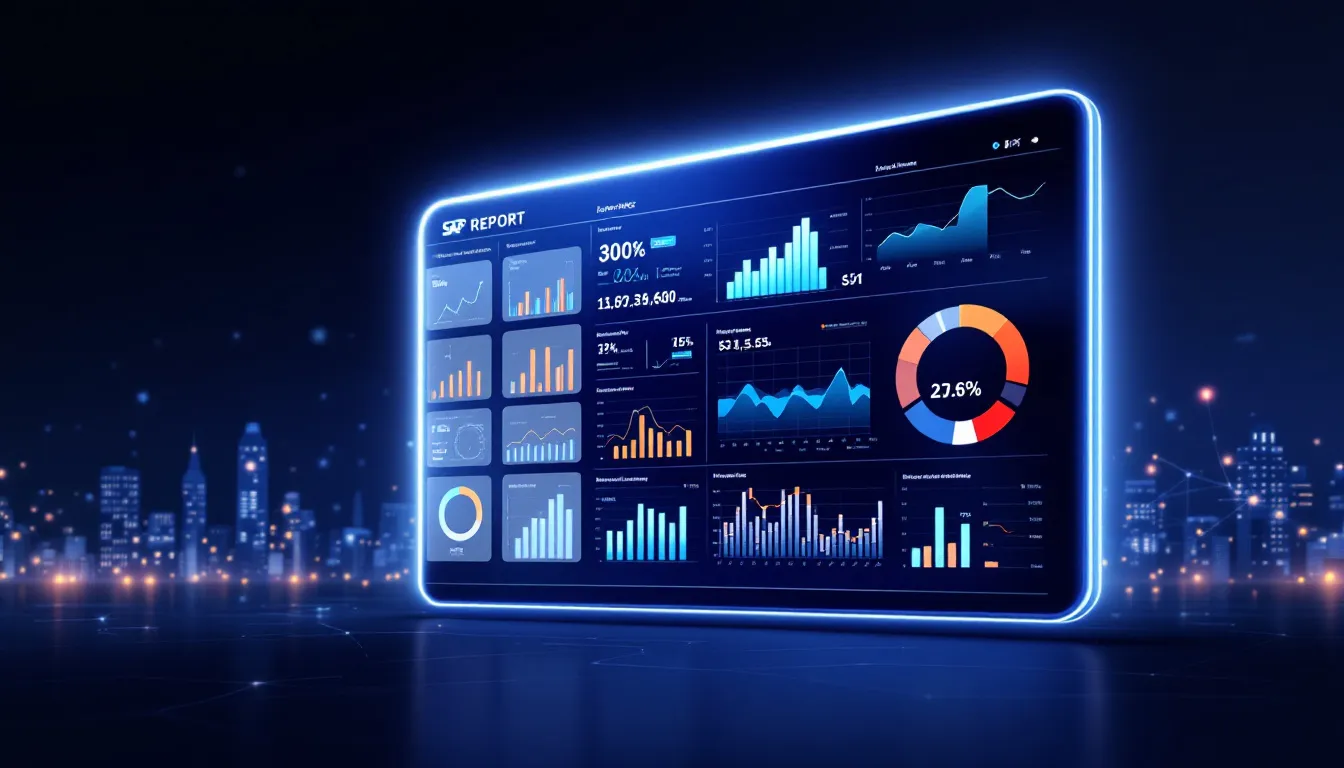Effective reporting is essential for organizations leveraging SAP solutions to drive informed decision-making and optimize business performance. SAP Reporting provides powerful tools and functionalities that enable users to extract, analyze, and visualize critical business data in real-time.
From operational reports to advanced analytics, SAP Reporting solutions ensure accuracy, transparency, and efficiency across various business functions. This article explores the key features, benefits, and best practices for leveraging SAP Reporting to enhance data-driven decision-making and business success.
Key Takeaways
- SAP Reporting tools aid in informed decision-making by providing accurate and timely insights into business performance across various functions, such as finance, sales, and production.
- Custom SAP reports, generated through tools like ABAP and SAP Query, allow organizations to tailor reports to specific needs, enhancing operational efficiency and collaboration.
- Advanced reporting techniques, including SAP HANA and BusinessObjects, facilitate real-time data analysis and visualizations, improving overall business intelligence and responsiveness.
Understanding SAP Reporting
SAP Reporting encompasses a range of tools and functionalities that allow users to generate detailed reports, track key performance indicators, and analyze real-time business insights. By offering valuable insights into business performance, SAP Reporting helps companies optimize operations, identify trends, and respond to market changes.
Whether using SAP S/4HANA Embedded Analytics, SAP BusinessObjects, or SAP BW/4HANA, these reporting solutions allow organizations to make data-driven decisions, improve operational efficiency, and enhance overall business performance.
Importance of SAP Reports
SAP reports provide accurate, timely information that aids in informed decision-making. They serve multiple purposes, including financial reporting, inventory management, and sales analysis. Additionally, its well-configured search infrastructure ensures accuracy and reliability, enabling businesses to optimize operations and make more strategic decisions.
How SAP Generates Reports
SAP offers multiple tools for generating reports, including SAP Query, ABAP reports, and SAP BusinessObjects. These tools enable users to create reports with just a few clicks, making the process efficient and user-friendly. The ability to access any data point from SAP databases allows for comprehensive analysis and ensures that businesses can tailor their reports to meet specific needs.
Standard SAP Reports for Business Processes

SAP provides various predefined reports crucial for optimizing business operations. These standard reports cover multiple types, including configuration assignments, development assignments, document assignments, end-user role assignments, and executable assignments. Leveraging these reports helps businesses streamline processes, improve performance, and make data-driven decisions.
Financial Reports
Standard financial reports available in the SAP Financial Accounting module include the Balance Sheet, Profit and Loss Statement, and Cash Flow Statement. These reports provide a comprehensive analysis of financial performance, allowing organizations to maintain records related to assets, revenues, and expenditures. Real-time data in SAP Financial Reporting offers timely insights, aiding informed decision-making and avoiding outdated information.
Sales and Distribution Reports
SAP Sales and Distribution reports provide a comprehensive overview of sales activities, helping organizations track and analyze sales performance data effectively. Standard reports included in the Sales and Distribution module of SAP are the Sales Order Report, Delivery Report, and Billing Report.
Material Management Reports
Standard reports in the Material Management module are essential for tracking material flow and optimizing inventory management. Here’s a look at the reports and their core purposes.
- Material Master Report: Provides detailed information about the materials in inventory.
- Purchase Order Report: Tracks core purchasing activities and business transactions.
- Goods Receipt Report: Monitors the receipt of goods into inventory for accurate tracking.
Production Planning Reports
Production Planning reports, such as the Production Order Report, Capacity Planning Report, and Material Requirements Planning Report, are essential for managing production efficiency and stock levels within the SAP landscape. These SAP data reports help organizations ensure smooth production processes and optimal resource utilization across business units.
Human Resources Reports
Standard SAP reports, like Employee Master Report, Payroll Report, and Time Evaluation Report, in the Human Resources module provide a comprehensive overview of HR activities. These reports help organizations manage their workforce effectively and ensure compliance with HR policies and regulations.
Custom SAP Reports for Unique Business Needs
Custom SAP reports are tailored documents that address specific organizational needs, further enhancing operational efficiency and performance. Various tools within SAP, such as ABAP and SAP Query, are utilized to create custom reports. They provide synchronized insights across different applications, enabling quicker and better decision-making.
Ad Hoc Query Reports
Ad hoc reports enable users to generate reports spontaneously, adapting to immediate business questions. Users can create ad hoc reports on the fly to quickly address pressing business inquiries and ensure the reports meet the user’s exact needs.
SAP Query Reports
SAP Query reports support user-defined criteria, allowing for tailored insights based on specific organizational needs. SAP Fiori allows users to personalize and customize reports based on their specific needs, enhancing the overall user experience. Additionally, real-time actionable insights help businesses make more informed decisions.
QuickViewer Reports
QuickViewer reports are utilized to create straightforward reports that fulfill specific business needs. They provide a streamlined approach for users to create reports without extensive technical knowledge. The ease of creating QuickViewer reports makes them a valuable tool for users with limited programming expertise.
Advanced SAP Reporting Techniques
Advanced SAP reporting methods facilitate deeper insights and help in complex data analysis. These techniques significantly enhance business intelligence and decision-making capabilities. Here’s a closer look at a few key capabilities of Advanced Reports in SAP.
ABAP-Based Reports
ABAP (Advanced Business Application Programming) is a high-level programming language created by SAP for developing applications on the SAP platform. It is used to create sophisticated reports that cater to specific organizational needs.
ABAP offers advanced features like data dictionary integration, modularization, and interface management, facilitating the development of complex reporting solutions.
SAP HANA Reports
Reports based on SAP HANA offer real-time data analysis for timely decision-making and insights. These reports deliver critical insights from large datasets in real time, enabling organizations to perform complex queries swiftly without data replication.
Fiori Reports
SAP Fiori reports offer a modern interface that enhances usability and user interaction with data. These reports are user-friendly and provide personalized insights based on the user’s role, improving engagement and delivering actionable data tailored to the user’s responsibilities.
Analytical Reporting in SAP
SAP Analytical reports help analyze and interpret large data sets, providing critical insights into key sales trends, inventory levels, and customer behaviors. Tools like SAP Crystal Reports generate interactive reports and integrate them with Microsoft applications for enhanced reporting.
SAP Business Warehouse Reports
SAP Business Warehouse is a data warehousing and reporting solution for consolidating data from various sources. SAP BW reports provide a detailed perspective on critical business operations like financials, sales, and inventory. Businesses can create custom reports in SAP BW to meet specific needs, enable in-depth analysis across organizational units, and enhance decision-making capabilities.
SAP BusinessObjects Reports
SAP BusinessObjects is a reporting and analytics tool for complex reports. They offer various data visualization features, including charts, graphs, and other visualizations. SAP BusinessObjects allows for user collaboration and sharing for better productivity across business teams.
Enhancing SAP Reporting Efficiency
Automating Report Generation
SAP Crystal Reports allows users to generate reports automatically based on database fields, streamlining report creation. Reports can be scheduled to run in the background, automating manual processes and freeing up resources for other tasks.
Automated data processing in production planning reports facilitates the analysis of production efficiency and resource allocation to automate processes.
Real-Time Data Access
Real-time data access provides up-to-date business insights that inform decision-making. Access to real-time data enables businesses to react swiftly to changing market conditions, ensuring they stay competitive and responsive. Fiori reporting capabilities include real-time analytics and mobile accessibility for on-the-go reporting whenever and wherever users need it.
Integrating Reports with Existing Systems
Effective report integration in SAP requires a well-configured search infrastructure. Publishing content to a centralized catalog makes it easier for teams to find relevant reports and ensures all systems work seamlessly together as an integrated solution.
Sharing and Collaborating on SAP Reports

Exporting and Sharing Reports
SAP reports can be exported to various formats, such as CSV, XLSX, and PDF, enhancing usability. This improves the accessibility of reports for stakeholders, ensuring the data can be used across different platforms and applications.
Collaborative Tools for SAP Reporting
Interactive chat and comment consolidation in SAP reporting tools enhance team collaboration. SAP Crystal Reports viewer allows users to navigate reports efficiently, contributing to collaborative efforts. SAP Analytics Cloud enables team discussions by grouping collaboration activities into focused threads for better communication.
Overcoming Common SAP Reporting Challenges
Managing Large Data Sets
Optimizing SAP report performance is crucial to efficiently processing large data sets and maintaining responsiveness. Techniques such as indexing, proper data modeling, and efficient query design can significantly improve report performance.
Analytical tools compatible with SAP help businesses manage large data sets, leading to insightful reporting and decision-making.
Ensuring Data Accuracy
Data accuracy and reliability in SAP reporting are critical for informed decision-making across business operations. Robust version control functionality in SAP Crystal Reports ensures that report changes are tracked and managed effectively, further maintaining data integrity.
Scope assignment via dropdown functionality allows users to define included data sets, enhancing report accuracy with drill-down functionality.
Streamlining Report Customization
Customizing SAP reports tailors information to specific needs, enhancing decision-making and operational efficiency. When making changes to a custom report definition, users can ‘Save’ or ‘Save as’, providing options for managing report versions.
Adopting best practices such as consistent naming conventions and effective version control can also significantly streamline the reporting process and ensure accurate data across business units.
Get Started with SAP Experts
Surety Systems provides in-depth knowledge of reporting tools like SAP S/4HANA Embedded Analytics, SAP BusinessObjects, and SAP BW/4HANA, to help businesses like yours design and implement customized solutions tailored to your unique needs.
From data modeling to dashboard creation and performance optimization, our senior-level SAP consultants guide you through every step, helping to maximize your SAP investment and ensure seamless integration and actionable insights.
Contact Us
For more information about our SAP consulting services or to get started on a project with our team of expert consultants, contact us today.
Frequently Asked Questions
How can SAP reports be customized to meet specific business needs?
Custom SAP reports can be tailored to meet specific business needs using tools such as ABAP, SAP Query, and QuickViewer, which enable the creation of reports that provide targeted insights and enhance decision-making.
What are the benefits of using advanced SAP Reporting tools?
Advanced SAP Reporting tools significantly enhance business intelligence through deeper insights and real-time data analysis. Organizations can achieve more complex data analysis and improved user engagement by employing methods such as ABAP-based reports, SAP HANA reports, and Fiori reports.
How can businesses enhance the efficiency of SAP Reporting?
Businesses can enhance SAP Reporting efficiency by automating report generation, ensuring real-time data access, and integrating reports with existing systems. These measures streamline processes and improve decision-making capabilities.
How do organizations overcome common challenges with SAP Reporting?
Optimizing queries, implementing robust version control, and adopting best practices for customization can effectively address common challenges in SAP Reporting, such as managing large data sets, ensuring data accuracy, and streamlining report customization.




